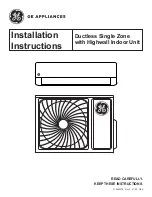
14
revised 10/09
Smog-Hog
PSH Series Model
4.1.10 PLACING PSH ONLINE
Depending upon job specifications or other
requirements, the PSH may be placed on line by a
customer-supplied switch, or a time clock, or through
a building maintenance system (BMS), refer to uaS
electrical Drawings. upon PSH start-up, the system
blower is placed on line and the power packs are placed
on line after a 45 second delay. the indicator light on
each power pack enclosure should be illuminated. the
power pack enclosure toggle switch should be checked
if the indicator light is not illuminated. if the indicator
light is not illuminated after checking the toggle switch
or the indicator light is flashing. refer to Section 10
troubleshooting. the uaS Main electrical Panel has
a 40 second time delay at start-up for the power pack
circuit. this represents a standard precaution since
PSH operates in applications where combustible gases
could be present in process enclosures or process
duct at start-up. the time delay of 40 seconds purges
the duct before activating the power pack circuit to
assure safe operation. for operation of auxiliary system
equipment, refer manufacturer’s owner’s instructions for
proper operating procedures.
4.1.11 UAS ON SITE START UP
the PSH system may include on site start up by a
uaS field Service technician. usually this is listed
on the order acknowledgment. as installation nears
completion, allow at least two weeks for scheduling a
uaS field Service technician. contact uaS customer
Service for a start-up request form. the completion of
the request form is required before scheduling a uaS
field Service technician. the on site start up consist
of a complete mechanical and electrical inspection
including the operation of all supplied uaS equipment.
UAS Field Service Technician is available for on site
service at a daily rate plus travel and expenses.
5. MAINTENANCE ANd MANUAL
CLEANING
The PSH unit should be inspected frequently and
collected contaminant removed from the system
regularly to prevent excessive accumulation
which may result in a flashover or risk of fire.
5.1 Recommended Maintenance
once the system is operational, periodic maintenance
is necessary to assure proper performance. follow a
regular pattern of system observation and log abnormal
conditions. Since systems reflect the process under
control, maintenance patterns will vary accordingly.
5.1.1 CHECK POWER PACK ENCLOSURE
INdICATOR LIGHTS
the PSH should be monitored daily by observing that
the indicator light is illuminated to each power pack
enclosure. occasional arcing (flashing of an indicator
light) is normal. an established arcing condition
or dead short condition (continuous flashing of an
indicator light) or the indicator light is not illuminated
is not normal should be corrected. refer to Section 10
troubleshooting.
5.1.2 IONIzER(S) ANd COLLECTOR CELL(S)
a visual inspection of a few modules could identify
problems such as moderate to extreme contaminant
build up to the ionizer(s) and collector cells even though
the indicator lights are illuminated. this will be helpful
in scheduling manual cleaning of the components,
refer to Section 7 and 8. to check the condition of the
ionizer and collector cell components, place the PSH off
line. open the module door and perform the grounding
procedure, refer to figures 17 and 18, inspect the
condition of the ionizer and collector cell components,
filters, door feed-thru insulators and interior of the
cabinet. experience will dictate whether contaminant
build-up is excessive. contaminant build up will
decrease high voltage to the ionizer and collector cell
circuits and also system efficiency. When accessing a
module, always clean the two door feed-thru insulators.
inspect the ionizer section, noting the condition of the
contact spring (distorted?, bent? missing?), acorn nut
(missing?), ionizer standoff insulators (contaminant
build up) and ionizer wires (contaminant build up?,
missing?), repair or replace. ionizer wires should be
taut and centered between ground plates. Ground
plates between each ionizer wire should be straight and
parallel. ionizer module support tracks should be free
of contaminant build-up for ground contact.
inspect the collector cell, noting the condition of the
contact spring (distorted? bent? missing?) cell contact
screw (missing?), cell plates (bent? warped?) should
be parallel and straight, repair or replace. cell hot
plates (smaller dimensional plates) should be centered
between ground plates (larger dimensional plate).
cell plates should not have contaminant bridging
between the cell plates or at support structure corners
or the triangular insulators collector cell module support
tracks should be free of contaminant build-up for ground
contacts.
5.1.3 FILTERS, dRAIN SUMPS, ANd
ACCESS dOOR GASKET INSPECTION
inspect filters, noting the condition (contaminant
build up? media separation? bent frames?) should
not have contaminant build up restricting airflow,
repair or replace.
Module drain sumps should not have moderate to
extreme contaminant build up or an accumulation
of wash water if equipped with in Place cleaning,
clean module sumps as required. component
doors gaskets should be in-place and in
good condition.
!
CAUTION
















































